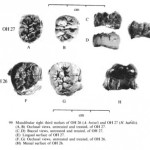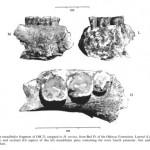Search the database
IMPORTANT NOTE: We have maintained the originally published taxonomic designation for each specimen despite the fact that many of these specimens have been reclassified since. We chose to follow this protocol because of the difficulty in keeping up to date with all of the taxonomic groups, and our hesitancy to make a judgement call on taxonomic debates. As such, please search the database with this in mind, perhaps using higher level taxonomic classifications for your query.
Search Results
Toggle Columns
- Image
- Spec #
- CODI Database ID
- Arch. Locality
- Geo. Locality
- Elements Preserved
- Excavation Date
- Repository
- Bed
- Level
- Stratigraphic Horizon
- Bibliographic Information
- Curatorial Notes
- ID By
- ID Date
- Research Team
- In Situ
- Sediment or Matrix Adhering
- Class
- Order
- Suborder
- Infraorder
- Superfamily
- Family
- Subfamily
- Tribe
- Genus
- Species
- Subspecies
- Taxonomic Notes
- Taxonomic Problems
| Image | Spec # | Elements Preserved | Repository | Family | Genus |
|---|---|---|---|---|---|
 |
OH 27 | R-M | 122 - National Museum and House of Culture, Dar es Salaam, Tanzania | Hominidae | Homo |
 |
OH 26 | R-M | 122 - National Museum and House of Culture, Dar es Salaam, Tanzania | Hominidae | Australopithecus |
| OH 25 | L-PAR-f | 122 - National Museum and House of Culture, Dar es Salaam, Tanzania | Hominidae | ||
| OH 24 | CRA , M , P | 122 - National Museum and House of Culture, Dar es Salaam, Tanzania | Hominidae | Homo | |
 |
OH 23 | L-MAN-f , L-P , L-M , | 122 - National Museum and House of Culture, Dar es Salaam, Tanzania | Hominidae | Homo |